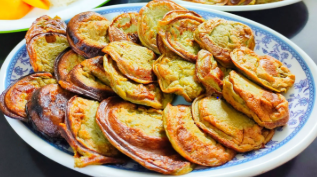ARTS AND CULTURE INFORMATION GATEWAY
Immerse yourself in the colorful world of art and culture! From traditional heritage to contemporary works, discover uniqueness that reflects the nation's identity and identity
AKOK
Picture
1
Video
No record
Today's Visitor
881
Number of Visitors
2321
Introduction and history
Kuih Akok is one of the most popular traditional desserts in the East Coast states of Malaysia, particularly in Kelantan and Terengganu. This kuih (dessert) is renowned for its rich sweetness, coconut aroma, and golden-yellow color. Akok is a symbol of cultural and heritage pride for the Malay community, with its preparation emphasizing the use of local ingredients.
Origin of Kuih Akok
Name and Origin
Kuih Akok is believed to have originated in Kelantan and Terengganu, with various stories about its beginnings. The name "Akok" might derive from the Malay word "Akok," which refers to its shape resembling a "rock" or "supporting structure."
Traditionally, this kuih is prepared in small cup-like shapes using molds, giving it its unique appearance.
History of Kuih Akok
Kuih Akok is believed to have existed since the era of the Malay Sultanates on the East Coast. Initially, it was prepared as a special dish for celebrations and feasts.
Over time, it became a staple at various occasions such as Eid celebrations, communal feasts (kenduri), and large family gatherings.
Cultural Influence
This kuih reflects the rich culinary heritage of the East Coast Malay culture, which is renowned for its use of natural ingredients like eggs, coconut milk, palm sugar, and rice flour. It embodies the diversity of traditional Malay cuisine, emphasizing the use of local resources.
Festive and Communal Dish:
Kuih Akok is often served during major celebrations like Eid and kenduri, functioning as a dessert to complement heavier meals.
Symbolic Food:
Kuih Akok symbolizes hospitality in Malay culture. Preparing and serving this dessert to guests reflects respect and courtesy.
-
Main Ingredients:
Chicken eggs
Coconut milk
Palm sugar or coconut sugar
Wheat flour
Pandan leaves
Flavoring Ingredient:
Salt: Adds a slight balance to the taste of the kuih.
Preparation Method for Kuih Akok
Combine palm sugar, water, and pandan leaves. Cook until the sugar dissolves. Remove the pandan leaves and let it cool slightly.
Add coconut milk, flour, salt, eggs, and the sugar water into a blender. Blend until fully mixed and frothy (the kuih akok batter is naturally runny). Strain the mixture.
Preheat the oven for 15 minutes at 200°C. Grease the molds with oil. Place the molds in the oven to heat.
Remove the molds from the oven and pour the batter into the molds, filling them to the brim. Bake for 15 minutes, lowering the temperature to 180°C. Use both top and bottom heat.
The kuih will puff up while baking. Once removed from the oven, it will shrink slightly. Let it cool for a while before serving.
Reference Source
Bahan Bacaan
Hassan, N. H., & Abdullah, R. (2015). Warisan Hidangan Tradisional Pantai Timur. Kuala Lumpur: Dewan Bahasa dan Pustaka.
Zain, M. I. (2018). Rasa dan Tradisi: Hidangan Melayu Asli. Shah Alam: Penerbit Universiti Teknologi MARA.
Azman, A. (2020). Makanan Warisan Kelantan: Dari Dapur ke Meja. Kota Bharu: Pustaka Kelantan.
Tokoh (jika ada temu bual tokoh)
Location
State JKKN Contact Information
Encik Wan Mohd Rosli bin Wan Sidik
Cultural Officer
Jabatan Kebudayaan dan Kesenian Negara, Kelantan
Kompleks JKKN Kelantan
Lot 1993, Seksyen 49,Tanjong Chat,
15200, Kota Bharu,
KELANTAN DARUL NAIM
09-741 7000









